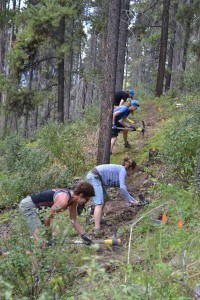
There’s a trail in Jasper, winding off the Marjorie Lake Loop, that isn’t on official maps. They won’t send you there from the Visitor Information Centre, and it’s marked only by a few scattered signs.
It’s one of the park’s many wildlands trails—maintained not by Parks Canada but by the volunteers from the Jasper Trail Alliance—and it’s aimed toward Jasperites looking for an experience that takes them off the beaten path.
But the trail has a problem: one section that climbs a steep hill is badly eroded. It doesn’t follow a logical line, and its sub-optimal design makes it not only less enjoyable for trail users, but also more dangerous.
That’s where Igor Hoogerdoorn comes in.
Hoogendoorn works with the International Mountain Biking Association in Canada, and on Aug. 7 he was in Jasper lending his vast knowledge of trail design to the trail alliance, helping volunteers design and build a section of trail that will bypass the old, eroding line.
The IMBA does this kind of work across Canada, and has come to Jasper several times over the past five years to help the trail alliance improve its trails. It’s important work, Hoogendoorn explained, because even though he designs trails from a biker’s perspective, a properly designed trail is safer and more enjoyable for all users.
Standing near the eroding section of trail last Thursday, he explained to the gathered trail alliance volunteers why the section was problematic.
“This is a really good example of where trail design can actually end up increasing the potential for conflict, and that is something we obviously want to avoid,” he said.
“You can see the side-slopes along this area, and you can see the trail really does follow it perfectly. This is a textbook example of an area that will continue to erode. You can see the initial signs here: the rock is being exposed, the roots are being exposed. If you look closely you can even see sediment puddles at the bottom.”
The volunteers, leaning on large tools and spraying themselves with bug spray, nodded in fascination.
Trail design is all about water, and it’s a serious science. If a trail isn’t properly designed, water will flow along it and wash it out. Laying out the details, Hoogendoorn spoke with a technical flair, dropping terms like “bench cutting,” “grade reversals” and “excavating organics.”
The day before, he had hosted a workshop at the train station, and the Thursday gathering was everyone’s opportunity to put their new knowledge to use. As the work began, the volunteers used tools borrowed from firefighters—tools with names like Pulaskis, pickmatics and McLeods—to cut roots, grade slopes, pack soil and move rocks.
The plan was to bypass the bad section of trail with a long oxbow that featured a built-up “switchberm” turn that required a retaining rock wall. The sound of metal scraping rock ricocheted around the forest, and dust from the dry earth filled the air, creating a pale brown haze. The woods smelled like bug spray and hot dirt.
A few hours into the work session, Sue Cesco of the Friends of Jasper National Park stopped for a drink of water. She said the alliance loves having the IMBA come to Jasper, because people like Hoogendoorn know how to design trails that everyone gets the most out of.
“We like anything that we can kind of do to increase the level of respect between users—that’s really the priority—and it seems like it’s been working, and people are quite respectful in Jasper in making sure there’s room for everyone on the trail.”
Part of that is maintaining interesting new trails to keep adventure seekers from setting out on their own, creating trails that might damage ecologically sensitive areas.
“[The wildland trails] are the ones that are a little harder to find, so people have to seek out that adventure a little harder, because they’re not always on all the maps that are given out to people.
“One of the things about giving people an option like this is that it keeps them on the trails—they’re interesting, they’re technical, it keeps them there and away from creating they’re own trails in areas where the wildlife has to be protected,” she said.
According to Cesco, the approximately 500 metre section of trail will take all summer to complete, and take about 300 volunteer hours. Last year the trail alliance racked up a total of 900 volunteer hours improving the park’s trails, and it’s on pace to do the same this year.
With the technical skills and insight provided by Hoogendoorn, trail users can count on some exciting new features on Jasper’s trails.
Trevor Nichols
[email protected]
